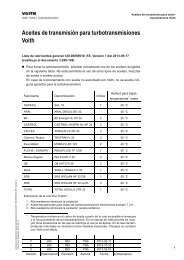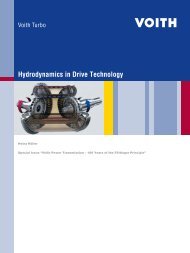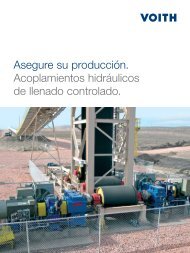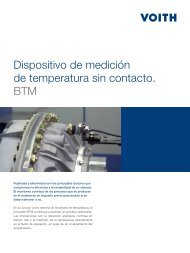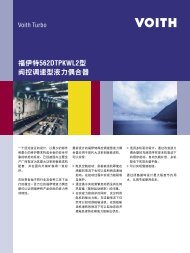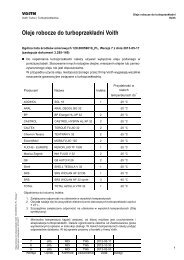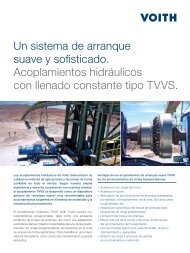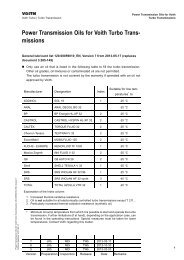Download PDF - Voith Turbo
Download PDF - Voith Turbo
Download PDF - Voith Turbo
Create successful ePaper yourself
Turn your PDF publications into a flip-book with our unique Google optimized e-Paper software.
System Competence<br />
for Belt Conveyor Drives.<br />
1
There are Good Reasons<br />
to Talk with Us<br />
Increasing delivery rates, longer conveyor routes, higher outputs<br />
and more stringent re quirements regarding reliability lead<br />
to ever growing demands on the drives used in modern belt<br />
conveyors.<br />
The belt is often the most expensive component and thus determines<br />
the size of the investment and the economics of the<br />
entire system. Fluid couplings from <strong>Voith</strong> (turbo couplings) protect<br />
the belt and other conveyor components and help reduce<br />
investments costs while providing max imum power transmission<br />
at the same time.<br />
More than 100,000 <strong>Voith</strong> <strong>Turbo</strong> fl uid couplings are in use on<br />
belt conveyors worldwide. They have proven their value under<br />
the harshest op erating conditions: under extremely challenging<br />
topography, in the cold and in the heat as well as under continually<br />
changing conditions.<br />
An ongoing dialog with research institutes, con veyor manufacturers,<br />
belt manufacturers and belt operators ensures state-ofthe-art<br />
techno logy for <strong>Voith</strong> products and systems compe tence<br />
for opti mum interaction among all components of the belt conveyor<br />
system.<br />
When it comes to suitable solutions in this spe cial fi eld of drive<br />
technology, <strong>Voith</strong> <strong>Turbo</strong> is your competent partner with extensive<br />
drive system expertise. We have been manufacturing<br />
hydro dynamic couplings for belt conveyors for over 50 years.<br />
2
Success-oriented Partnership –<br />
from the very Beginning<br />
When it comes to designing modern belt conveyor systems, <strong>Voith</strong> <strong>Turbo</strong><br />
stands ready as an experienced partner.<br />
For us, system competence means:<br />
• Comprehensive consultation re garding all areas of the conveyor<br />
system that are affected by the drive<br />
• Supplying drive components that are perfectly suited to the<br />
operat ing conditions<br />
• Commissioning<br />
• A worldwide service network that assures you maximum<br />
system availability and profi tability<br />
We will be happy to advise you re garding these points when<br />
laying out and designing the drive con cept that is best-suited<br />
for your applica tion.<br />
Our declared goal is to always achieve the optimum cost /<br />
benefi t ratio for our customers. With their worldwide presence,<br />
our subsidiar ies and representatives assist in this regard by<br />
providing direct contact with you as well as fast, widely available<br />
service.<br />
3
Your demanding specifi cations contain<br />
challenging requirements – <strong>Voith</strong> fl uid couplings<br />
meet them!<br />
To achieve longer belt conveyors with increased performance,<br />
modern drives must provide higher power output. At the same<br />
time, drive units should protect the equipment and machine<br />
components, be reliable and cost-effective. A drive can meet<br />
these requirements only if it satisfi es the following.<br />
4
Requirements for belt conveyor drives<br />
• Load-free motor run-up<br />
• Use of low-cost squirrel cage motors requiring little maintenance<br />
• Gradual build-up of start-up torque until the break-away<br />
torque of the drive is reached<br />
• Limitation of the maximum torque during start-up<br />
• Adapting the start-up torque to the particular load conditions<br />
• Reducing longitudinal tension waves in the belt<br />
• Load sharing in multi-motor drives<br />
• Staggered start-up of motors in multi-motor drives in order<br />
to avoid a cumulative inrush current<br />
• Simple handling and compact construction<br />
• Operation characterized by min imal wear and maintenance<br />
• Possible use of water as the op erating fl uid, especially in<br />
under ground mining applications<br />
Your specifi cations will contain add itional detailed requirements.<br />
A dis cussion with a <strong>Voith</strong> technical rep resentative will<br />
show you that we can provide engineered relia bility in your<br />
drive solution. Give us the opportunity!<br />
5
Configuration of belt conveyor with multiple drives<br />
Intermediate drives<br />
Main drive<br />
Belt<br />
Tail drives<br />
Tensioning mechanism<br />
It All Depends on the Following…<br />
Main drive<br />
When selecting the correct drive concept, more and more<br />
decisions are being made in favor of multi-motor drives with<br />
lower output in stead of a single higher output drive. The<br />
reasons for this include the resultant lower inrush currents as<br />
well as the ability to transmit power to several drive pulleys.<br />
Tensioning mechanism<br />
To prevent belt slippage at the pul ley, the takeup device must<br />
provide adequate pre-tension on the belt under all operating<br />
conditions. The more uniform and gradual the ac celeration,<br />
the smaller is the pre-tensioning force required.<br />
<strong>Voith</strong> fl uid couplings permit stag gered start-up of motors in<br />
order to prevent simultaneous inrush cur rents. The individual<br />
motors are subjected only to the start-up torque of the <strong>Voith</strong><br />
fl uid coupling.<br />
A natural load sharing during the start-up operation ensures<br />
that overloading of individual motors is avoided. Depending<br />
on the type and design, <strong>Voith</strong> fl uid couplings offer the ability<br />
to limit the start-up torque to values between 1.1 to 1.6 of the<br />
nominal torque.<br />
6
Belt<br />
The belt is often the most expensive component of the conveyor<br />
system. Its purchase price is greater when it must transmit<br />
higher drive traction during the start-up operation. <strong>Voith</strong><br />
fl uid couplings limit the torque ap plied and thus minimize the<br />
tension on the belt.<br />
The benefi ts: The belt is subject to less stretch, leading to increased<br />
service life for the belt and belt splices. In addition to<br />
use of lower-cost belts, minimizing the accelera tion torque<br />
means easier curve transitions for the belt.<br />
Tail drives<br />
Drive stations at the tail are often a practical location for a<br />
brake, since the braking force acts directly on the load carrying<br />
side of the belt. The tail drive also reduces the tension on<br />
the belt in multi-drive systems. It should be possible to adjust<br />
this drive variably to the load distribu tion.<br />
Often, the tail drives only power the return side of the belt, in<br />
which case only the necessary power require ment is used for<br />
sizing purposes.<br />
Intermediate drives<br />
Intermediate drives, such as “tripper booster” drives – dis tribute<br />
applica tion of drive torque over the entire conveyor. By<br />
splitting up the drive points along the conveyor, the ten sion<br />
levels are signifi cantly reduced, thus permitting use of lowercost<br />
belts. Use of intermediate drives generally requires a suitable<br />
control mechanism, since each drive must be adjusted<br />
individually to the belt segment associated with it.<br />
7
The Right Solution for Each Drive<br />
<strong>Voith</strong> <strong>Turbo</strong> satisfi es the variety of requirements for drives in<br />
belt conveyor systems with a comprehensive line of couplings.<br />
Depending on the system-specifi c demands of the customer,<br />
the appropriate coupling is supplied for each drive and an optimum<br />
cost / benefi t ratio is achieved.<br />
The Type TV fl uid coupling with de lay chamber is usually used<br />
when lower power outputs are required. During start-up, a<br />
large portion of the operating fi lling is retained in the attached<br />
delay chamber. As a con se quence, less torque is trans mitted<br />
during the start-up operation and the driven machine starts up<br />
under lower load. The resulting gradual, uniform ac celeration<br />
of the belt dur ing the course of start-up extends the service<br />
life of the belt.<br />
TV<br />
Constant-fi lled fl uid coupling with delay chamber<br />
8
For situations where start-up with a lower torque is necessary,<br />
use of the fl uid coupling Type TVV with enlarged delay chamber<br />
can further reduce the start-up torque of the coupling and<br />
thus achieve an even more gradual acceleration of the conveyor.<br />
Even more demanding require ments on the drive are satisfi ed<br />
by using the Type TVVS fl uid coupling with the additional annular<br />
cham ber. It produces an especially low start-up torque<br />
and provides an extended torque build-up which results in an<br />
automatic adjustment to the particu lar load condition.<br />
TVV<br />
Constant-fi lled fl uid coupling with enlarged delay chamber<br />
TVVS<br />
Constant-fi lled fl uid coupling with enlarged delay chamber<br />
and annular chamber<br />
9
The primary design factors for a coupling are the power require<br />
ment, mass moment of inertia of the belt, and the speed<br />
of the drive motor. The coupling‘s size is determined from the<br />
nominal demand power and the motor speed. Depending on<br />
how the de sign criteria for the belt conveyor are weighted<br />
(page 5), a var iety of start-up characteristics can be achieved<br />
by selecting the appropri ate coupling.<br />
With fi ll-controlled couplings, the degree of fi lling can be varied<br />
dur ing operation. Motor run-up occurs at almost no load with<br />
a drained coupling. Fill control couplings also allow the conveyor<br />
to be accelerated precisely to follow a programmed<br />
„S-shaped“ speed-time ramp. These units limit the maximum<br />
accelera tion forces and provide acti ve load sharing, tension<br />
control for booster drives, and controlled deceleration.<br />
DTPK<br />
Fill-controlled fl uid coupling, externally supported<br />
TPKL<br />
Fill-controlled fl uid coupling, self-supported<br />
10
The Type DTPK is a coupling that is externally supported by<br />
motor and gearbox shaft. It is very com pact in size, needs no<br />
connecting couplings and operates with almost no wear.<br />
The Type TPKL is a self-supported coupling. The concept<br />
permits sim ple handling and for this reason is recommended<br />
specifi cally for use in underground mining applications.<br />
The Type TPKL-T is alignment-free, as both motor and gearbox<br />
are connected to the coupling by inter mediate tunnel<br />
housings. The entire drive can be attached to and de tached<br />
from the drive pulley on-site without diffi culty.<br />
The <strong>Turbo</strong>Belt 780 TPXL is a new highly effi cient and compact<br />
fi ll controlled fl uid coupling specifi cally designed for 6 and<br />
8 pole belt conveyor drives. The highly integrated and compact<br />
design eases commissioning and benefi ts mobile belt<br />
conveyor units. The coupling features the new XL runner profi<br />
le for higher power transmission rates.<br />
TPKL-T<br />
Fill-controlled fl uid coupling, tunnel design<br />
<strong>Turbo</strong>Belt TPXL<br />
Fill-controlled fl uid coupling, fl anged to motor<br />
11
cr293en, S&F / WA, 04.2012, 2 000. Dimensions and drawings are given for information only. Subject to modifi cations.<br />
<strong>Voith</strong> <strong>Turbo</strong> GmbH & Co. KG<br />
Start-up Components<br />
<strong>Voith</strong>str. 1<br />
74564 Crailsheim, Germany<br />
Tel. +49 7951 32-409<br />
Fax +49 7951 32-480<br />
startup.components@voith.com<br />
voith.com / fluid-couplings




